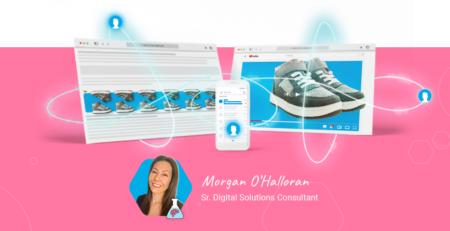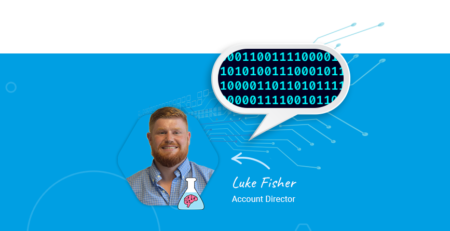Why we’re tired of the “data vs creativity” debate: they should never have been separated in the first place
The argument of data versus creativity has been plaguing marketing for some time now: as digital marketing nudged in on traditional agencies’ turf, there was an outpour of support for the creative side of things. Thankfully, most opinion pieces are now tending to lean towards the idea that data and creativity have to work in harmony to produce good work, although some still persist in praising the ‘human’ virtues of creativity, largely ignoring the role data has to play.
Nothing exists in a vacuum. Data and creativity are inextricably linked. Acting as if the two can be separated in today’s digital world is the problem: excellent creatives require excellent data architecture.
Data: the building blocks of any creative
Let’s start at the beginning. Before a campaign is even started, there should be steady communication between marketing and creative teams. Gathering information about potential customers is easy, especially on social platforms, so there is no excuse for not having some sort of picture of what your target audiences look like. Previous campaigns, lookalikes and other audience insights can also help teams inform the creative unit of who is going to be looking at their ads.
This ability to break audiences down into different segments allows for basic targeting, but personalization options beyond this means that highly relevant messaging is becoming the norm for consumers.
The rise of zero party data (i.e. specific data that is given by the user) is a double-edged sword, as marketers will have much more explicit data to work with, but will have to work to even higher levels of expectation when it comes to creatives and personalisation.
Brands will also have to be more creative with how they ask for this information, too: a boring form just won’t cut it anymore.
However, zero party data should mean that ads become more cost-efficient to advertisers, and more desirable to the people looking at them.
For example, if a pop-up on a retail website asks a shopper to state their shoe size, the advertiser can always ensure that when they’re retargeting they show users ads for styles that are in stock or on sale in that specific size. This increases the likelihood of a sale and reduces the annoyance of clicking on an advertised item only to see your size isn’t available.
Going one step further: you could ask your customers to fill in a profile, giving them access to a discount as well as never showing them things they actively don’t want to see.
What’s the point of creating a beautiful ad if it doesn’t add any value for the customer, and can’t be linked back to improved performance?
The human element of data
Those extolling the ‘human aspects’ of creativity also need to remember that marketing is – and has always been – by people, for people. The digital age hasn’t changed that one bit.
Data science helps us to advise creative teams on what elements would work well in an ad, but it is also crucial to understanding what impact the ad had. What people like, how long they looked at it, when they bought it, what they saw to encourage them to get it, whether they’ll want to buy it again – it’s all about human behaviour.
Back in the 60s, a computer programme named ELIZA caused a stir with her ability to mimic human conversation. Designed to sound like a therapist, ELIZA was initially a hit, and even spawned the idea that computers could be used as affordable therapy. But people soon realised that a computer – even a very intelligent one – is no replacement for a real person.
In the same way, the analysis of human behaviour and the corresponding data can only successfully be done by people – people trained in data analysis, but also with life experiences, emotions and empathy. Even ELIZA, programmed to sound kind and caring, was only giving the illusion of empathy.
And who’s devising, making and continuously optimising the clever tools that do that work? You guessed it – humans. If that’s not creative, I don’t know what is. Our computers and tools are almost unimaginably clever, but that doesn’t make up for the fact they are not like us.
To call creativity the ‘human element’ is reductive: data, and therefore modern marketing, is intrinsically human.
Data and creativity in action
Sometimes, it seems that the point of ads has been forgotten: winning awards is great, but at the end of the day what we want is conversions.
Let’s take a look at some ads by a brand that has been hitting the marketing headlines for their creatives recently. Burger King’s Christmas 2019 bit, ‘A Whopper of a Secret’ poked fun at McDonald’s in a way only the underdog could do. Continuing the attacks on their arch nemesis, the recent ‘Mouldy Whopper’ venture divided audiences with its explicit (read: gross) visuals.
But what have these ads actually achieved – has this gotten them any closer to toppling McDonald’s from their parapet, or are they just ‘ads for ad people, by ad people?’
Let’s have a look at another one: their 2019 ‘Traffic Jam Whopper’ ad.
There is data all over this. It’s covered in stats, information which likely helped the creative teams decide where to set the spot initially.
Real-time data, the ad says, allowed them to ‘detect potential buyers’, ‘offer Whoppers’ and then ‘deliver on the move’. Simply branded billboards displayed how exactly long drivers would be stuck in traffic for, and urged them to satiate themselves with a Burger King delivery – some even called out specific drivers to alert them to their burger’s ETA.
The ad shows real-time tweets, it displays the app interface, and it tackles the obvious issue of texting while driving by showing how the food can be ordered by voice command.
It’s fun, it’s innovative, and it looks great. And the results are right there in the video. A 63% increase in delivery orders was accompanied by a 44% increase in daily download rate, making Burger King’s the number one fast food app in Mexico. Thanks to the stunt, they’ll be repeating it in LA, São Paulo and Shanghai. It is a shining example of how data can lead to a brilliant and effective creative.
That’s my point exactly: it’s not about chopping it all up and saying ‘look at some data at the beginning, be creative in the middle, check your results at the end’. Data and creativity need to work together every step of the way. Otherwise, what’s the point?




